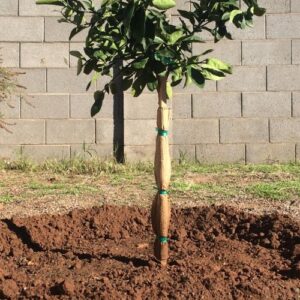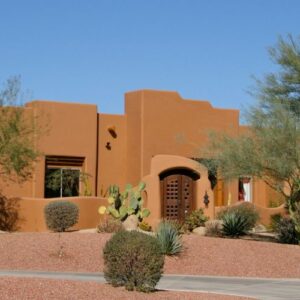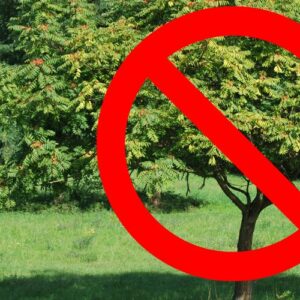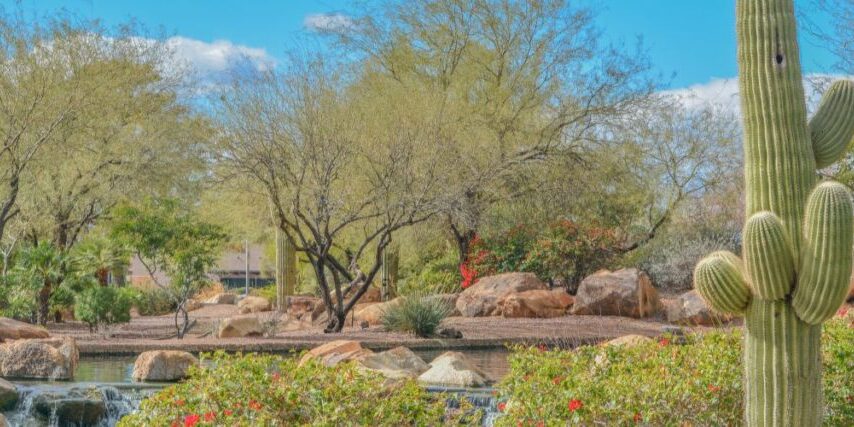
In the landscapes of North Phoenix and Anthem, the choice of trees in your garden or community space is more than just a matter of aesthetics; it’s a strategic decision that impacts the local environment, water conservation, and the overall ecological balance. North Phoenix, with its unique blend of urban and natural elements, requires careful consideration of tree species that can thrive in its distinct climate while enhancing the beauty and sustainability of our surroundings.
Whether you’re looking to create a shaded oasis in your backyard, contribute to the urban canopy, or add a touch of nature’s elegance to your property, understanding the best tree options is crucial. Join us as we explore the top tree recommendations for North Phoenix landscapes, designed to flourish in our climate and bring lasting beauty and benefits to your outdoor spaces.
Key Takeaways
- Selecting tree species that thrive in North Phoenix’s climate enhances local ecology and landscape sustainability.
- Deciduous and evergreen trees offer diverse options for creating shaded, aesthetically pleasing outdoor spaces.
- Understanding a tree’s mature size, sunlight requirements, and root behavior is essential for optimal placement and growth.
- Incorporating native cacti can add unique textures and forms to a landscape, complementing traditional tree selections.
- Consulting with tree care professionals and adhering to local guidelines ensures successful and compliant landscape projects.
The Best Trees for North Phoenix Landscapes
Selecting suitable trees for your North Phoenix landscape is crucial for ensuring long-term growth, sustainability, and aesthetic appeal. The region’s hot summers and mild winters require species that are drought-resistant and capable of thriving in the local soil and climate conditions.
Below, we delve into a curated selection of trees ideal for North Phoenix environments, highlighting their overall appearance, flowering season, mature size, sunlight requirements, and best uses in the landscape.
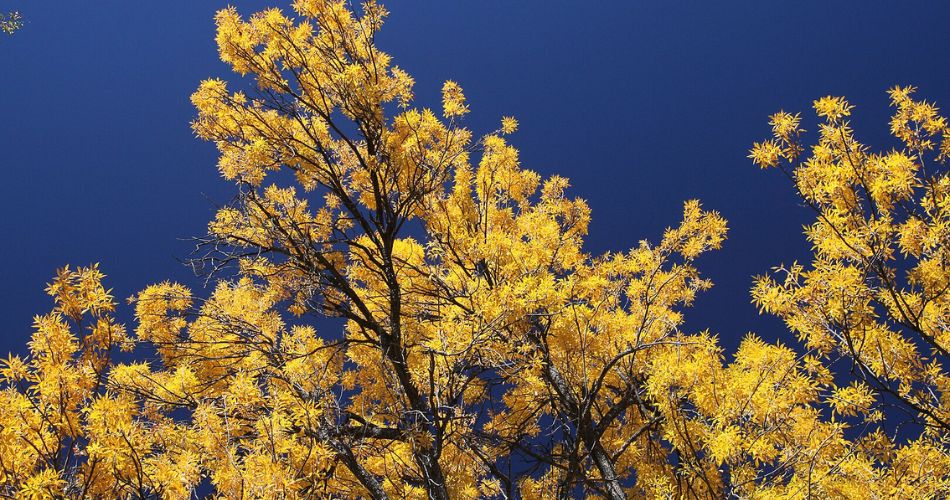
Arizona Ash (Fraxinus velutina)
Overall Appearance
This deciduous tree boasts a lush canopy of dark green leaves that turn yellow or purple in the fall, providing seasonal interest. Its bark is smooth on young trees, becoming furrowed with age.
Flowers/Fruit and Timing
Small, inconspicuous flowers appear in spring, followed by winged seeds that disperse with the wind.
Size at Maturity
It can grow up to 30-50 feet tall and wide, offering substantial shade.
Sunlight Requirements
Prefers full sun to partial shade.
Best Uses in the Landscape
It is ideal for large yards or parks where its size and shade can be fully appreciated.
Learn more about Arizona ash trees and other shade trees
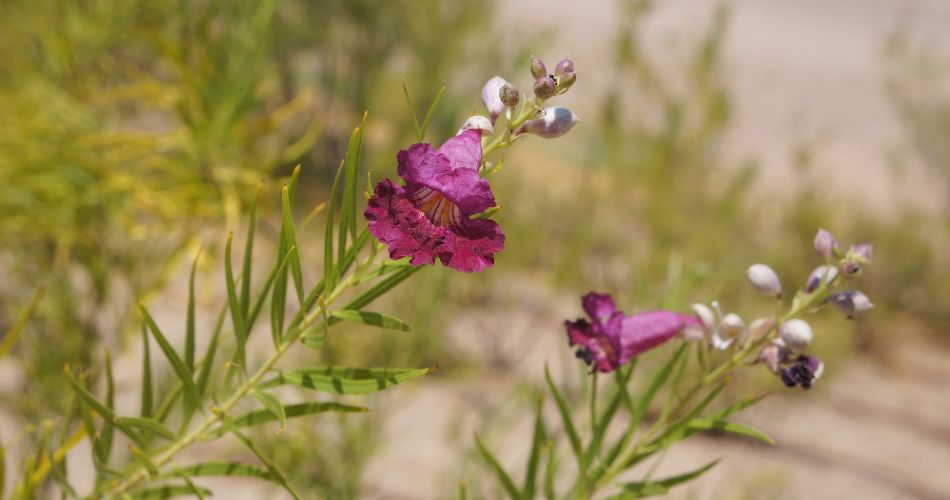
Desert Willow in Bloom: Pink Hues of the Desert
Desert Willow (Chilopsis linearis)
Overall Appearance
A deciduous tree with a willow-like appearance featuring narrow, long leaves and a spreading canopy. Its bark is dark and furrowed.
Flowers/Fruit and Timing
Produces vibrant pink to lavender flowers from late spring to early fall, attracting hummingbirds and butterflies.
Size at Maturity
Reaches 15-30 feet in height and width.
Sunlight Requirements
Thrives in full sun.
Best Uses in the Landscape
Suitable for natural gardens, erosion control, or as a focal point in residential landscapes.
Read more about desert willows in our article on the best spring-flowering trees.
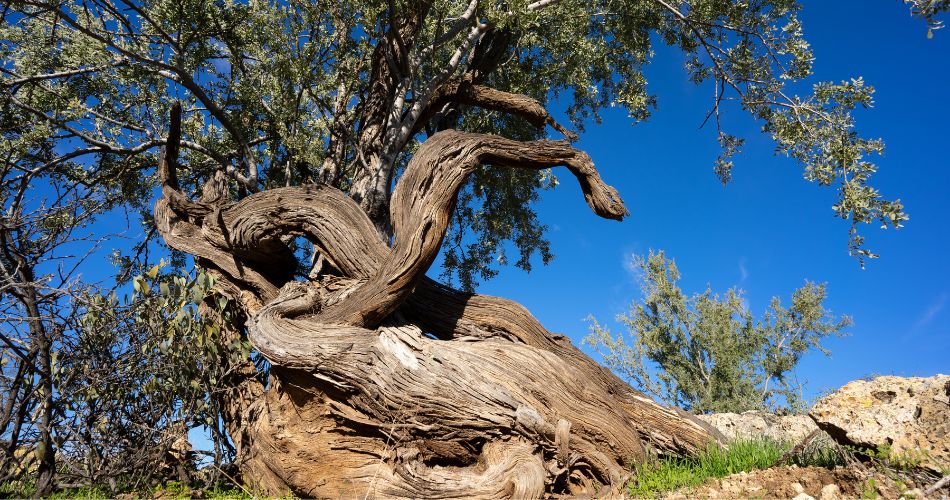
The Sturdy Ironwood: Sentinel of the Desert
Ironwood Tree (Olneya tesota)
Overall Appearance
An evergreen tree with a dense, rounded canopy and gray-green leaves. Its bark is deeply furrowed, providing textural interest.
Flowers/Fruit and Timing
Showy purple flowers bloom in late spring, followed by seed pods.
Size at Maturity
Typically grows 15-25 feet tall but can reach up to 45 feet.
Sunlight Requirements
Prefers full sun.
Best Uses in the Landscape
Excellent for providing year-round shade and as a windbreak or privacy screen.
See some FAQs about desert ironwood trees here >>
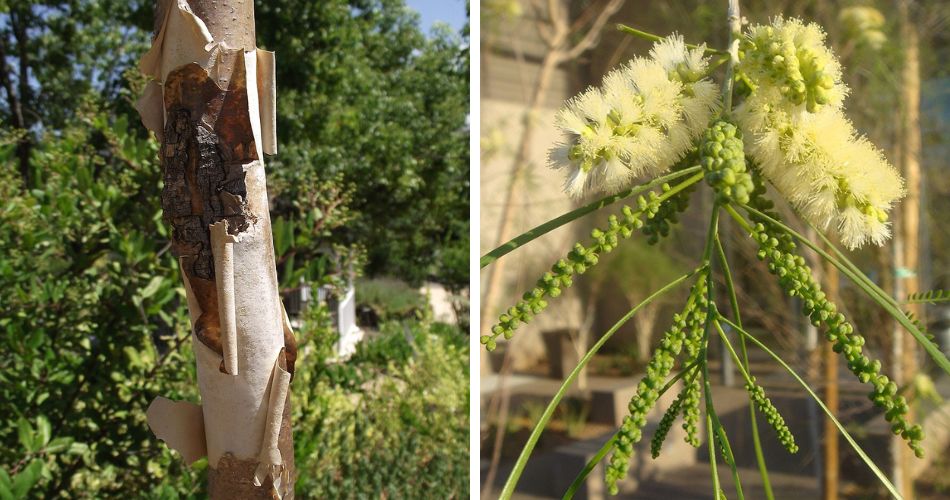
Palo Blanco’s Elegance: Sleek White Bark and Delicate Foliage. Image on the right courtesy of Miwasatoshi – Own work, CC BY-SA 4.0,
Palo Blanco (Acacia willardiana)
Overall Appearance
Known for its striking white, smooth bark and feathery, light green foliage, this tree has a graceful, upright growth habit.
Flowers/Fruit and Timing
Clusters of creamy white flowers emerge in spring, adding a delicate fragrance to the air.
Size at Maturity
Grows up to 20 feet tall and wide.
Sunlight Requirements
Best in full sun.
Best Uses in the Landscape
Perfect as an accent tree in smaller gardens or in groups for a dramatic effect in larger landscapes.
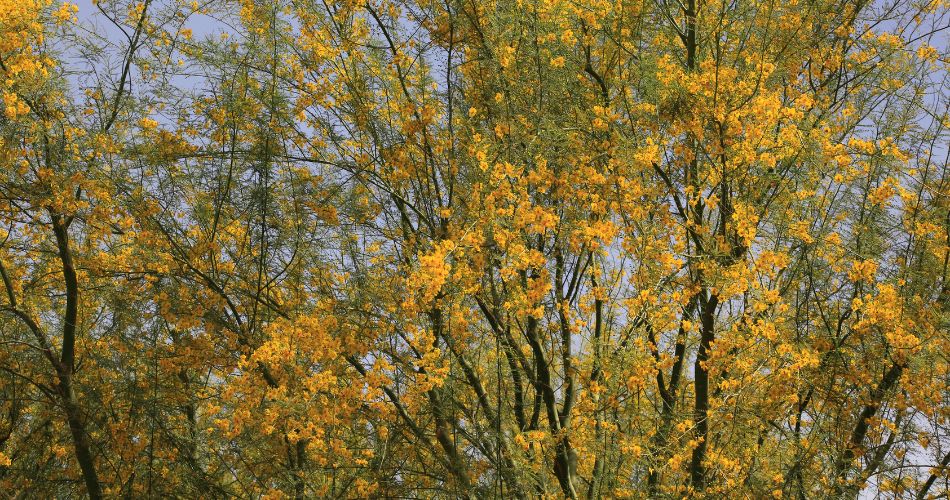
Vibrant Yellow Blooms of the Desert Museum Palo Verde
Desert Museum Palo Verde (Cercidium ‘Desert Museum’)
Overall Appearance
This hybrid palo verde stands out with its thornless branches, bright green bark, and a lush canopy of small, fern-like leaves, creating a striking silhouette against the landscape.
Flowers/Fruit and Timing
It blooms with vibrant yellow flowers that cover the tree in late spring to early summer, offering a spectacular display without producing the pods common to other Palo Verdes.
Size at Maturity
A fast-growing tree that can reach 20-30 feet in height and spread, forming a natural umbrella shape.
Sunlight Requirements
Requires full sun to flourish, making it perfect for the sunny conditions of North Phoenix.
Best Uses in the Landscape
Ideal as a focal point in xeriscape gardens, public parks, or as street trees where its drought tolerance and low maintenance are highly valued.
Read more about Arizona’s state tree, palo verde
Learn which palo verde tree would work best for your landscape
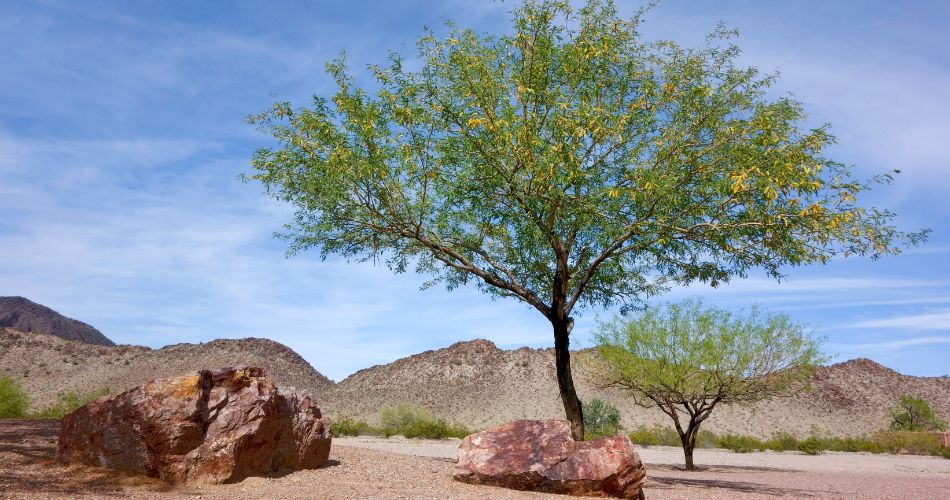
The Hardy Native Mesquite: A Canopy Spread Wide
Native Mesquite (Prosopis spp.)
Overall Appearance
Native Mesquites are rugged, resilient trees with a wide, spreading canopy. Their deep green leaves and rough, textured bark add depth and character to any landscape.
Flowers/Fruit and Timing
Produces small, yellow flowers in late spring followed by long, edible pods in the summer, which are a valuable food source for wildlife.
Size at Maturity
Can grow up to 20-30 feet tall and even wider, with some specimens spreading to 40 feet.
Sunlight Requirements
Prefers full sun, thriving in the intense heat of North Phoenix.
Best Uses in the Landscape
Works well in large open spaces, as a shade tree, or in naturalized areas where its deep root system can help control erosion.
Read some of the pros and cons of having mesquite trees in your landscape >>
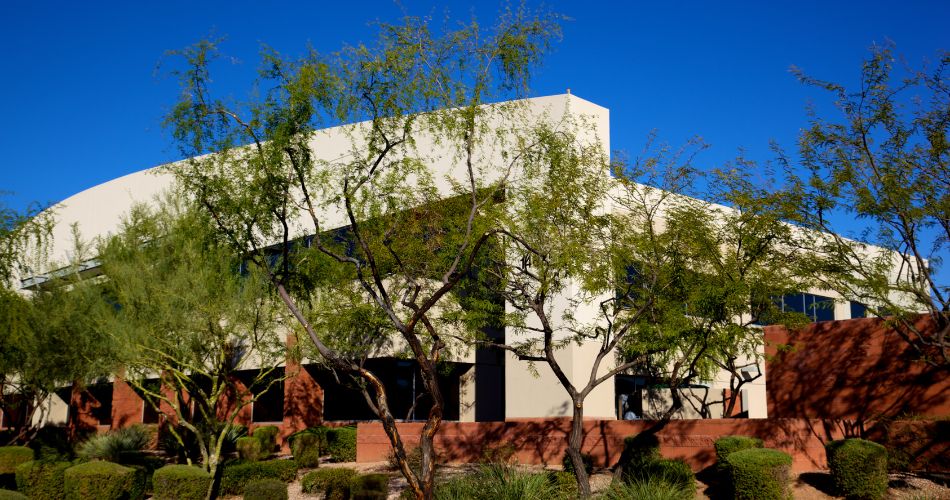
Whitethorn Acacia: A Dance of Light and Shadow
Whitethorn Acacia (Acacia constricta)
Overall Appearance
This small to medium-sized tree features a rounded canopy of dark green, feathery leaves, contrasted with white, sharp thorns and a rugged, dark bark.
Flowers/Fruit and Timing
Blooms with small, yellow, puffball-like flowers in the spring and early summer, which turn into twisted, brown seed pods.
Size at Maturity
Grows to about 10-20 feet in height and spread, making it a versatile choice for smaller areas.
Sunlight Requirements
Full sun is best, aligning perfectly with the tree’s adaptation to desert environments.
Best Uses in the Landscape
Ideal for creating natural barriers, accentuating rock gardens, or as part of a mixed shrub border for added texture and interest.
Learn more about sweet acacia, another type of acacia, in our article about spring-flowering trees.
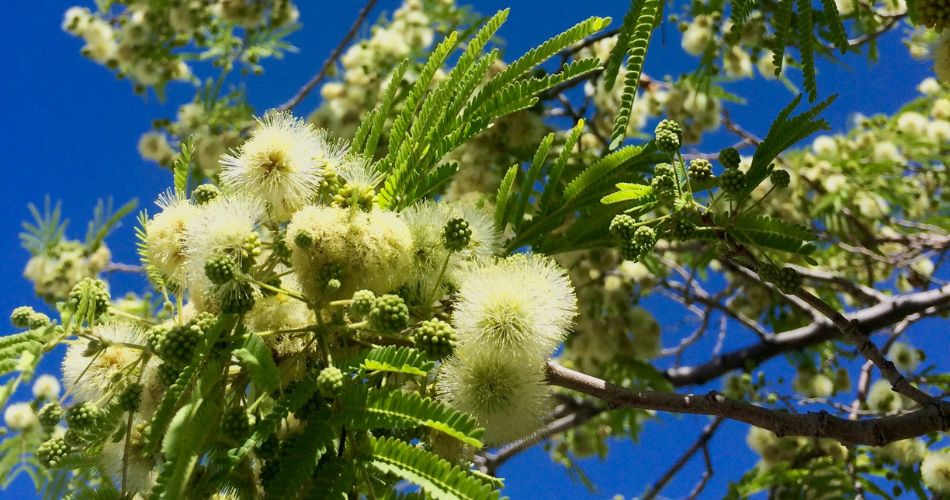
Feather Bush: Delicate Beauty in the Desert Heat
Desert Fern/Feather Bush (Lysiloma thornberi)
Overall Appearance
This attractive tree offers a delicate, fern-like appearance with its bipinnate leaves and a graceful, spreading form. Its smooth, light gray bark adds to its elegance.
Flowers/Fruit and Timing
Showcases clusters of fluffy, white flowers in late spring to early summer, which attract pollinators and add a soft, airy feel to the landscape.
Size at Maturity
Typically reaches 15-25 feet in height and width, with a well-balanced and rounded canopy.
Sunlight Requirements
Thrives in full sun to partial shade, providing flexibility in garden placement.
Best Uses in the Landscape
Perfect as a specimen tree in residential yards, under larger canopies in park settings, or along walkways where its gentle presence can be fully appreciated.
Learn more about this tree and other shade trees
We also mentioned this tree in our article on excellent evergreen trees.
Choosing trees that match the specific conditions and aesthetic of North Phoenix ensures their survival and enhances the local ecosystem, providing benefits for years to come. In the following sections, we’ll explore additional tree options and discuss important tree placement and care considerations in North Phoenix landscapes.
Tree Placement Tips for the Phoenix Area
Creating a sustainable landscape in the Phoenix area requires thoughtful consideration of tree placement. The right location ensures the tree’s health and growth and maximizes its environmental and aesthetic benefits. Here are some essential tips for evaluating the ideal placement of trees in urban, suburban, or rural settings in Phoenix:
Evaluate Canopy and Root System Size
Consider the mature size of the tree’s canopy to ensure it has enough space to spread without interfering with buildings, power lines, or other structures. This foresight prevents future pruning that could compromise the tree’s health and shape.
Understand the tree’s root behavior to avoid potential issues with foundations, sidewalks, and underground utilities. Trees with deep taproots, like the Native Mesquite, are generally safer for urban settings, while those with invasive roots require more space.
Consult Local Guidelines and Seek Expert Advice
Phoenix and its surrounding areas may have specific regulations regarding tree planting, especially in public rights-of-way or certain residential zones, such as the Anthem Country Club Community Association’s approved plant list. It’s crucial to consult these guidelines to avoid violations and ensure your landscaping project aligns with community standards.
Before making any decisions, consider seeking advice from local arborists or landscaping professionals. They can provide insights into the best tree species for your specific location, considering factors like soil type, sun exposure, and water availability. Titan Tree, for example, offers expert consultations tailored to the Phoenix area’s unique landscape requirements.
Plan for Success
Use landscape design tools or consult with professionals to visualize how your chosen trees will look as they mature. This planning phase helps create a balanced and cohesive landscape that will thrive for years.
Consider the long-term maintenance requirements of your selected trees and cacti. Some species may require more pruning, watering, or pest management than others. A well-planned landscape considers these factors, ensuring each plant’s needs are met without overwhelming the caretaker.
By following these tips and considering the unique aspects of the Phoenix landscape, you can create a beautiful, sustainable, and compliant outdoor space. Whether you’re enhancing an urban dwelling, a suburban home, or a sprawling rural property, the thoughtful placement of trees and cacti can make all the difference in achieving your landscaping goals.
Frequently Asked Questions
Q. Why is it important to select drought-tolerant trees for my landscape?
A. Due to the region’s arid climate, drought-tolerant trees are essential in North Phoenix. They help conserve water and ensure the sustainability of your landscape.
Learn more about how desert trees are different >>
Q. How often should newly planted trees be watered in North Phoenix?
A. Newly planted trees require more frequent watering to establish roots, typically once or twice a week deeply, but this can vary based on soil conditions and weather.
Q. What is the best time of year to plant trees in North Phoenix?
A. The best time to plant trees in North Phoenix is during the cooler months of fall to early spring, allowing roots to establish before the summer heat.
Q. How deep should I dig the hole when planting a new tree?
A. When planting a new tree, the hole should be dug two to three times wider than the tree’s root ball but only as deep as the root ball’s height to ensure optimal root expansion and stability.
Q. How can I ensure my trees remain healthy during extreme heat waves?
A. Adequate watering, providing shade for young trees, and applying mulch can all help trees survive and thrive during intense heat.
Cultivating Beauty and Sustainability in Phoenix Landscapes
Embracing the Phoenix area’s unique beauty and environmental conditions offers a remarkable opportunity to transform outdoor spaces into vibrant, sustainable landscapes. By carefully selecting and placing the right trees and incorporating native cacti, homeowners and businesses alike can create settings that thrive in the desert climate and enhance the local ecosystem and community aesthetic.
The journey to a beautiful and healthy landscape begins with understanding each plant’s specific needs and growth patterns. From the majestic spread of the Arizona ash to the delicate beauty of the desert fern, every choice contributes to the overall harmony and sustainability of your outdoor environment. By considering the size of the tree’s canopy and root system and diversifying with native cacti like the ocotillo or saguaro, you can ensure your landscape is beautiful and resilient.
However, successful landscaping in Phoenix continues after selection and placement. Compliance with local guidelines and ongoing maintenance are key to ensuring the longevity and health of your landscape. Consulting with experts, such as the team at Titan Tree, can provide you with the knowledge and services necessary to navigate these challenges effectively.
If you’re ready to transform your Phoenix area landscape into a sustainable oasis, Titan Tree is here to help. Our team of experts specializes in selecting, planting, and caring for trees and plants that thrive in the Phoenix climate. Whether you’re starting from scratch or looking to enhance your existing landscape, we offer tailored solutions to meet your specific needs.
Contact us today at 623-444-8448 to schedule a consultation and take the first step toward creating your dream outdoor space. Together, we can cultivate beauty and sustainability in the heart of the desert.
See Our Latest Articles
More Articles Like This

Titan Tree Care is a full-service tree care company located in Anthem, AZ and serving all of North Phoenix. We offer a wide range of services to meet your tree care needs, including tree and palm trimming, tree pruning, tree removal, stump grinding, and more. We also offer insect or disease treatments and fertilization services. We are dedicated to providing high-quality, safe, and effective tree care services to our customers and work hard to ensure that your trees are healthy and look their best.




